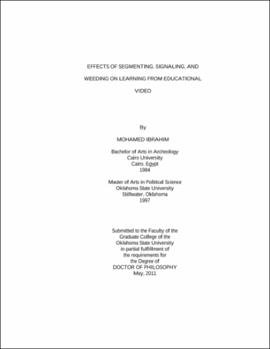| dc.contributor.advisor | Antonenko, Pasha | |
| dc.contributor.author | Ibrahim, Mohamed | |
| dc.date.accessioned | 2013-11-26T08:34:35Z | |
| dc.date.available | 2013-11-26T08:34:35Z | |
| dc.date.issued | 2011-05 | |
| dc.identifier.uri | https://hdl.handle.net/11244/7447 | |
| dc.description.abstract | Scope and Method of Study: | |
| dc.description.abstract | Informed by the cognitive theory of multimedia learning, this study examined the effects of three multimedia design principles on undergraduate students' learning outcomes and perceived learning difficulty in the context of learning entomology from an educational video. These principles included segmenting the video into smaller units, signaling to direct students' attention to relevant information, and weeding to remove any nonessential content (SSW). It was hypothesized that the SSW treatment would decrease perceived learning difficulty and facilitates transfer of knowledge and structural knowledge acquisition. This study used a quasi-experimental, between-subjects design to measure the effect of segmentation, signaling and weeding (independent variable) on four dependent variables: (1) perceived learning difficulty, (2) knowledge retention, (3) transfer of knowledge, and (4) structural knowledge acquisition. Prior knowledge and metacognitive awareness were included in the model as covariates. The instruction used in the present study was an educational video with two different designs. | |
| dc.description.abstract | Findings and Conclusions: | |
| dc.description.abstract | Results of the study demonstrate that participants in the SSW group outperformed the non-SSW group on the tests of knowledge transfer and structural knowledge acquisition and reported lower levels of learning difficulty. These findings support the use of segmenting, signaling, and weeding to help novice learners organize and integrate knowledge from complex, dynamic audio-visual media like video. | |
| dc.format | application/pdf | |
| dc.language | en_US | |
| dc.rights | Copyright is held by the author who has granted the Oklahoma State University Library the non-exclusive right to share this material in its institutional repository. Contact Digital Library Services at lib-dls@okstate.edu or 405-744-9161 for the permission policy on the use, reproduction or distribution of this material. | |
| dc.title | Effects of segmenting, signaling, and weeding on learning from educational video | |
| dc.contributor.committeeMember | Curry, John H. | |
| dc.contributor.committeeMember | Mendez, Jesse | |
| dc.contributor.committeeMember | Greenwood, Carmen | |
| osu.filename | Ibrahim_okstate_0664D_11337.pdf | |
| osu.accesstype | Open Access | |
| dc.type.genre | Dissertation | |
| dc.type.material | Text | |
| dc.subject.keywords | cognitive load | |
| dc.subject.keywords | educational video | |
| dc.subject.keywords | knowledge transfer | |
| dc.subject.keywords | multimedia learning | |
| dc.subject.keywords | structural knowledge | |
| thesis.degree.discipline | Educational Technology | |
| thesis.degree.grantor | Oklahoma State University | |
